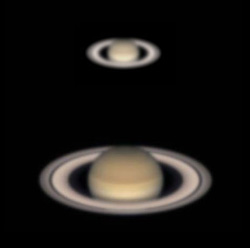Your first view of Saturn with a telescope can introduce you to the riches of stargazing — and now is the perfect time to see Saturn and all it has to offer!
[caption id="attachment_255423095" align="alignright
Your first view of Saturn with a telescope can introduce you to the riches of stargazing — and now is the perfect time to see Saturn and all it has to offer!
[caption id="attachment_255423095" align="alignright
 The rings were tilted 15° on February 7, 2012, when Robert English in Kentucky took this fine image using a 20-inch Newtonian reflector. The rings are tipped open even wider now.[/caption]
Saturn is entering the early evening sky this spring just as Jupiter begins its exit in the west. Here's a quick guide to spotting the ringed planet by eye and viewing it through a telescope.
On May 10th, Saturn reaches opposition, meaning it's opposite the Sun in the sky. It rises around sunset, glides across the sky all night, and sets near sunrise. Saturn is positioned among the dim stars of Libra, which keeps it relatively low in altitude even when it's highest in the middle of the night. But you won't have trouble spotting it: now gleaming at magnitude 0.1, splendid Saturn outshines all the stars in that part of the sky.
The rings were tilted 15° on February 7, 2012, when Robert English in Kentucky took this fine image using a 20-inch Newtonian reflector. The rings are tipped open even wider now.[/caption]
Saturn is entering the early evening sky this spring just as Jupiter begins its exit in the west. Here's a quick guide to spotting the ringed planet by eye and viewing it through a telescope.
On May 10th, Saturn reaches opposition, meaning it's opposite the Sun in the sky. It rises around sunset, glides across the sky all night, and sets near sunrise. Saturn is positioned among the dim stars of Libra, which keeps it relatively low in altitude even when it's highest in the middle of the night. But you won't have trouble spotting it: now gleaming at magnitude 0.1, splendid Saturn outshines all the stars in that part of the sky.

Here's how the ringed planet Saturn might look when seen through a telescope with an aperture 4 inches (100 mm) in diameter (top) and through a larger instrument with an 8-inch aperture (bottom).
You don't need a large telescope to get a nice view of Saturn. Even one with an aperture of just 60 mm (2.4 inches) should reveal the rings easily and, with a little more effort, the dark Cassini Division that splits the system into the outer A ring and inner B ring.
Like Jupiter, Saturn displays banded cloud tops. But its markings are more muted than Jupiter's, because there's more high-altitude haze in its upper atmosphere. You'll need a telescope at least 6 inches across to make out the bright Equatorial Zone, the slightly darker North Equatorial Belt, and the dusky North Polar Region.
As May begins, look for the thin black shadow of Saturn's globe on the rings. It diminishes just off the globe's celestial western side before opposition and reemerges on the the eastern side afterward. And watch for the Seeliger effect, a noticeable brightening of the rings for a few days around opposition.
[caption id="attachment_255423098" align="alignright
 S&T.com's Saturn's Moons JavaScript utility can help you find several of the planet's moons for any date and time. Here's the arrangement on the evening of May 11th.[/caption]
Saturn has the best set of visible moons of any planet! A 60-mm scope will usually reveal the giant moon Titan. A 4- or 6-inch adds Iapetus, Rhea, Dione, and (with a little difficulty) Tethys. A 10-inch might catch Enceladus. See just where to look for them, or identify the ones you see, with S&T.com's Saturn's Moons JavaScript utility or download our handy SaturnMoons app, available for $2.99 from the iTunes Store.
Many amateur skygazers remember a first view of Saturn as the thing that opened to them the riches of astronomy — so don't let this great opportunity pass you by. Here are more tips for observing Saturn.
And, of course, take every opportunity to show Saturn to your friends and neighbors!
S&T.com's Saturn's Moons JavaScript utility can help you find several of the planet's moons for any date and time. Here's the arrangement on the evening of May 11th.[/caption]
Saturn has the best set of visible moons of any planet! A 60-mm scope will usually reveal the giant moon Titan. A 4- or 6-inch adds Iapetus, Rhea, Dione, and (with a little difficulty) Tethys. A 10-inch might catch Enceladus. See just where to look for them, or identify the ones you see, with S&T.com's Saturn's Moons JavaScript utility or download our handy SaturnMoons app, available for $2.99 from the iTunes Store.
Many amateur skygazers remember a first view of Saturn as the thing that opened to them the riches of astronomy — so don't let this great opportunity pass you by. Here are more tips for observing Saturn.
And, of course, take every opportunity to show Saturn to your friends and neighbors!
Comments
XT6 Dob
May 6, 2014 at 5:59 pm
I recently flocked my Z10 and set a new center spot on Primary. I have spent a lot of my time over the past few night watching Saturn and I still can't believe the views I have gotten, Extremely sharp focus and I can easily make out the different color variations in its Orb. There is also a clear separation in the Cassini division. I found my best view was using a 25mm wide field EP in a 2x/3x barlow stack.
You must be logged in to post a comment.
You must be logged in to post a comment.